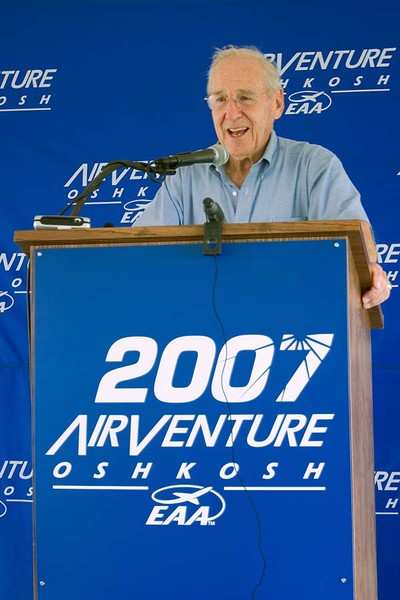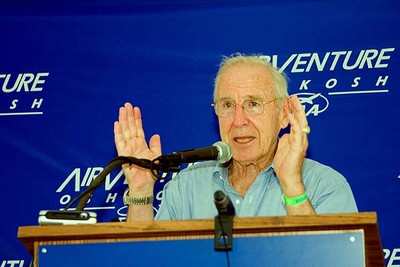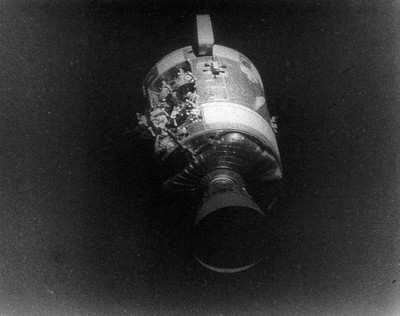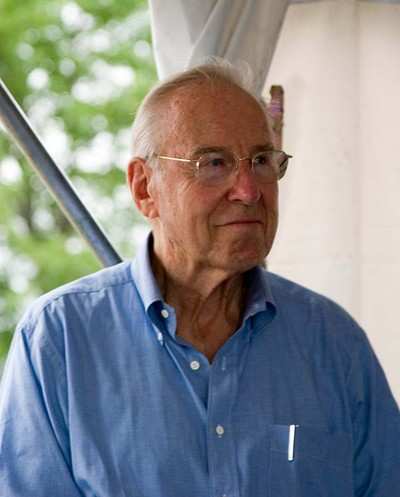Apollo 13 Commander "Not A Stranger To EAA"
While Captain Jim Lovell (USN, Ret.) is perhaps most well known
for his role as Commander of the ill-fated NASA Apollo 13 mission,
which was made even more famous by the 1995 movie of the same name,
many may not know of his long and extensive history as a General
Aviation pilot. Lovell shared some of that history with ANN at this
year's EAA AirVenture Oshkosh, an event he is quite familiar
with.

"I'm not a stranger to EAA; I've been here many times," Lovell
explained. He is also no stranger to Paul Poberezny, founder of the
EAA. "I first met Paul Poberezny years and years ago, when I was an
astronaut way back in the early 70s." Lovell had flown a T-38 into
Milwaukee's Mitchell Field in December for a family visit and
parked the aircraft at the Air National Guard base. He returned
that night and was about to climb into the cockpit when Poberezny,
a Colonel for the National Guard at the time, stopped him.
"'Son, have you checked that wing?'" Lovell quoted Poberezny
from their first meeting. "I ran my hand over the wing and it had
all sorts of clear ice on it." Poberezny took the plane into the
hangar and Lovell departed the next day after the ice had thawed.
"He essentially saved my life, because if I had taken that plane
off I would have never gotten off the ground, I would have been at
the end of the runway at Mitchell Field."

Lovell started flying in 1953 and earned his wings in 1954.
"I've flown every month since that time, except when I retired from
the navy." Lovell didn't fly for 16 months following his
retirement. "During that period I was getting withdrawal
symptoms."
He first intended to purchase a single engine aircraft, but
Lovell said lightly that his plan was shot down by his wife, who
didn't like the idea of flying in a small, single-engine aircraft.
Undaunted, he accommodated his wife by purchasing a Cessna 310,
which he owned for five years before upgrading to a quarter share
in a Cessna 441 Conquest turboprop - an airplane he and his
partners later sold, which Lovell regrets. "I wish I had that
airplane back again."
For the next 20 years, Lovell flew a Beech Baron E55 until
upgrading to the Cessna 421 Golden Eagle he still flies today. His
pioneering spirit showed in his interest and admiration of the
latest technology on display at Oshkosh. "There's a lot that I'd
like to fly," Lovell explained, specifically mentioning Eclipse
aircraft and the HondaJet, but he did admit that he'll probably
just stay with his 421.
Lovell stayed at AirVenture to introduce the showing of Apollo
13 at the Fly-In Theater. Lovell, who is played by Tom Hanks in the
movie, served as a technical consultant and, along with his wife,
made a cameo appearance.
"[Apollo 13 was] the most challenging flight that I had," Lovell
explained to ANN, "a classic case of crisis management, a classic
case also of how aircraft accidents are started - through a series
of incidents - and also a case of where good leadership and
teamwork and perseverance and initiate were the attributes that got
us back home safety."

Prior to Apollo 13, Lovell flew with fellow astronaut Frank
Borman on Gemini 7, a two week mission in 1965 to research
long-duration space flight. Lovell also flew with Edwin "Buzz"
Aldrin on Gemini 12, a mission to research extravehicular activity.
"Everybody forgot Newton's Third Law of Motion, for every action
there's an opposite and equal reaction, and we were fighting the
zero gravity rather than using it to help us." Gemini 12 helped
NASA research those and other EVA factors.

According to Lovell, his third mission, Apollo 8, was his most
important. Accompanied by astronauts Frank Borman and William
Anders, Lovell went to the moon and back after NASA changed the
parameters of the mission in order for the US to reach the moon
before Russia, its cold war adversary.
 ANN's Daily Aero-Linx (04.16.24)
ANN's Daily Aero-Linx (04.16.24) Aero-News: Quote of the Day (04.16.24)
Aero-News: Quote of the Day (04.16.24) Airborne 04.10.24: SnF24!, A50 Heritage Reveal, HeliCycle!, Montaer MC-01
Airborne 04.10.24: SnF24!, A50 Heritage Reveal, HeliCycle!, Montaer MC-01 Airborne 04.12.24: SnF24!, G100UL Is Here, Holy Micro, Plane Tags
Airborne 04.12.24: SnF24!, G100UL Is Here, Holy Micro, Plane Tags Airborne-Flight Training 04.17.24: Feds Need Controllers, Spirit Delay, Redbird
Airborne-Flight Training 04.17.24: Feds Need Controllers, Spirit Delay, Redbird






